Final report for OS18-118
Project Information
Degrading soil health, biodiversity, and soil resilience are major challenges to sustainable crop production under changing climates (Freckman and Virginia, 1997). Excessive tillage, inappropriate crop rotations, monocultures, excessive grazing or crop residue removal have degraded soils in the Southern U.S. crop production systems. Recent extreme climatic events that drastically affected the South have exacerbated soil degradation in this region. Soil health is strongly related with beneficial soil and ecosystem functions including water storage, decomposition, and nutrient cycling; and responds sensitively to land management practices and climate. According to the Organic Farming Research Foundation survey among farmers (National Organic Research Agenda, 2016), 42 percent of respondents in the Southern US demanded more research to identify cultural practices to improve soil health that would improve the resilience of production systems to extreme weather. Recently, much attention is being focused on cover cropping as a sustainable practice to achieve these goals.
Reducing weed pressure on crops without affecting soil health through intense and frequent tillage and cultivation practices is a major challenge in sustainable crop production. With the increasing interest toward organic grain production in the Southern U.S., fall cover crops could be explored as a sustainable practice that reduce weed pressure, as well as improving soil health and cropping system intensity and diversity. Even though the multiple functions make cover crops a whole-farm system approach for improving sustainability and profitability of cropping systems, few producers in the South have included cover crops as part of their cropping systems. A major reason being lack of knowledge regarding the suitable cover crops for their locality that lead to improved use of resources and soil health. In addition, farmers often ask, "Why should I plant a cover crop that uses up all my water?"
To address this issue, we conducted a study (2016-2017 and 2017-2018 field seasons) to evaluate the common fall cover crops in South Carolina for water use with the financial support of the Southern SARE On-Farm Research Grant program. In this research, we evaluated seven cover crop treatments [rye, crimson clover, rye/crimson clover mixture, oat/ radish mixture, crimson clover/turnip mixture, Austrian winter peas/rye/wheat/crimson clover/hairy vetch mixture (Mixture of 5a), and oats/wheat/crimson clover/radish/turnip mixture (Mixture of 5b). Our results indicated that none of the cover crop treatments depleted soil water more than a fallow control.
In the present study, we determined the effect of the same cover crops on soil health and weed suppression, and their impact on the performance of the following cash crop. Our results indicated that mixture of 5a, rye, and the mixture of rye and crimson clover were the best cover crops in terms of biomass production and improving the following cash crop (soybean) performance. However, mixture of 5a was superior when soil health improvements were also considered.
Evaluate cover crops belonging to brassica, grass and legume groups, as individual species and in mixtures for their benefits to soil health and weed suppression.
Cooperators
- (Researcher)
- (Researcher)
Research
The first season field trials were conducted in the fall and winter of 2019-2020 to evaluate cover crops for soil health and weed suppression, and their impact on the performance of the following cash crop. Seven cover crop treatments [rye; crimson clover, mixture of crimson clover and turnip; mixture of oat and radish; mixture of rye and crimson clover; mixture of Austrian winter peas, rye, wheat, crimson clover, and hairy vetch (mixture of five-a; recommended by Adams Brisco Seed Vendor); mixture of oats, wheat, crimson clover, radish, and turnip (mixture of five-b; NRCS recommendation)] were tested in the field trial. The control treatments were weed-free fallow (fallow with herbicide application) and a weedy fallow (fallow without herbicide application). Cover crops were planted (6.1 m x 6.1 m plots) at recommended seeding rates using a seed drill. Cover crops were terminated by chopping or mowing with a ‘John Deere Mower conditioner and Bail’. Two months after cover crop termination, soybean was planted using a no-till John Deere 1590 planter.
Experimental design for the field trial was a randomized complete block with 5 replications. Analysis of variance was performed using the GLIMMIX procedure in SAS.
Data collection:
Percent weed cover was estimated through the point intercept method to assess weed presence in field plots (Elzinga et al., 2001). Briefly, weed cover was measured by point intercept based on the number of "hits" on the weed species out of the total number of points measured along a transect line, and expressed as a %.
Cover crop biomass: Biomass was hand-harvested from 0.5 m2 area at 115 and 144 days after planting of cover crops. Just before termination, cover crop biomass was harvested with a carter forage harvester from 7.43 m2 (80 ft2) area within each plot to determine dry weight.
Cash crop (Soybean) performance: Soybean biomass was estimated from 1 m rows during the vegetative growth period of the crop (1 month after planting). Seed yield was estimated at maturity.
Soil health analyses
Soil health was assessed at cover crop termination and one month after soybean planting using the Haney test at the Ward Laboratories, Inc, Kearney, NE, which is an integrated approach to soil testing using chemical and biological soil test data. The Haney test at the Ward Laboratories involves a dual extraction procedure that determines pH, soluble salts, organic matter, soil respiration; H2O Extract: total nitrogen, total organic carbon, total organic nitrogen; H3A Extract: nitrate-nitrogen, ammonium-nitrogen, inorganic nitrogen, total phosphorus, inorganic phosphorus, organic phosphorus, potassium, calcium, magnesium. To conduct the Haney test, soil samples were collected from each plot and submitted to the Ward Laboratories.
Mixture of 5a was the best one in terms of stand establishment (Figure 1). Mixture of 5b, rye and mixture of rye and crimson clover were intermediate in terms of stand establishment. Crimson clover and the mixture of crimson clover and turnip were the worst in terms of stand establishment. Weed infestation was lower in cover cropped plots than the control treatments (Figure 2). This means that the cover crops were able to suppress weeds. Mixture of 5a, rye, and the mixture of rye and crimson clover produced the highest amounts of biomass, whereas mixture of 5b and the mixture of oat and radish produced intermediate and crimson clover and the mixture of crimson clover and turnip produced the least amounts of biomass (Figure 3).
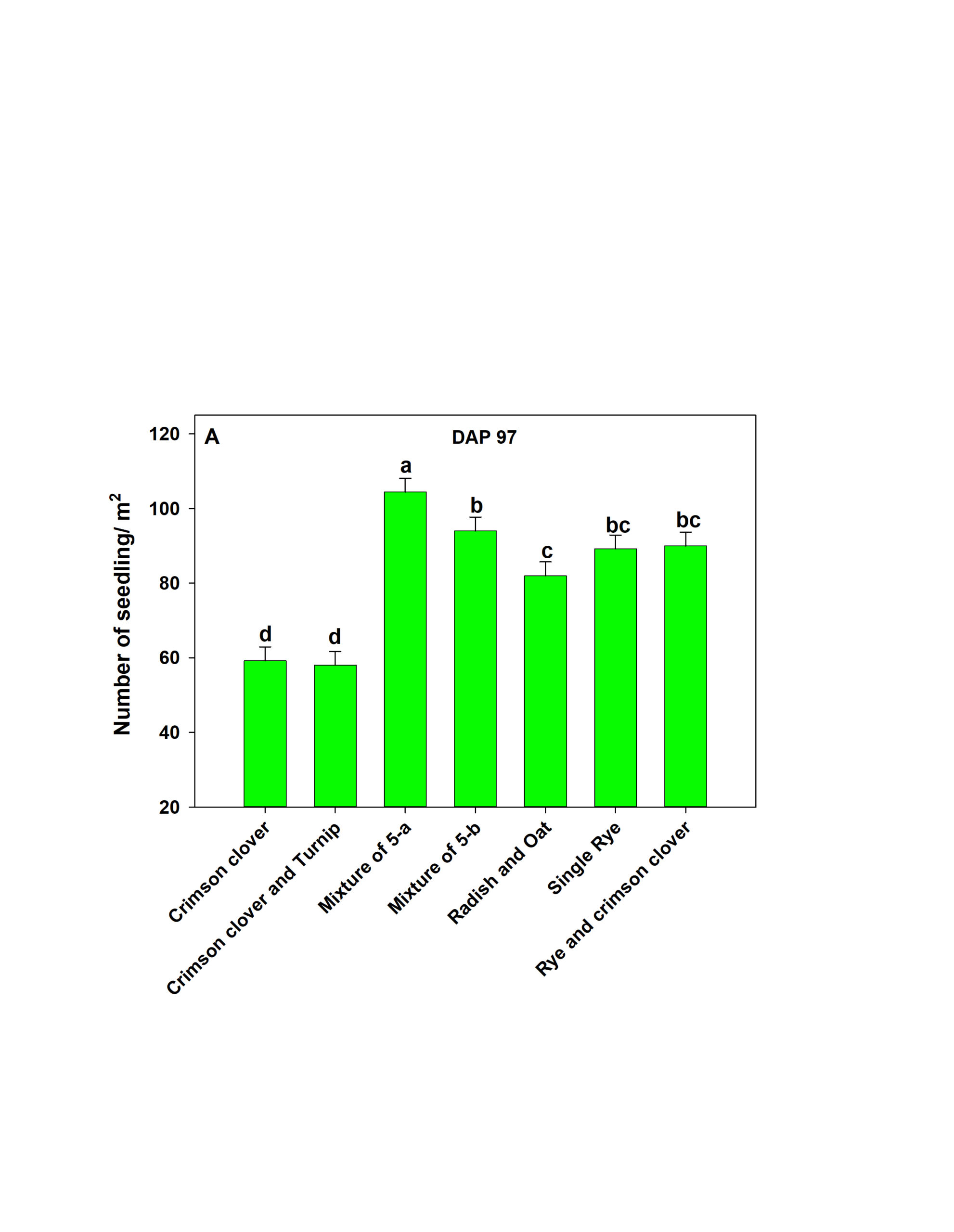
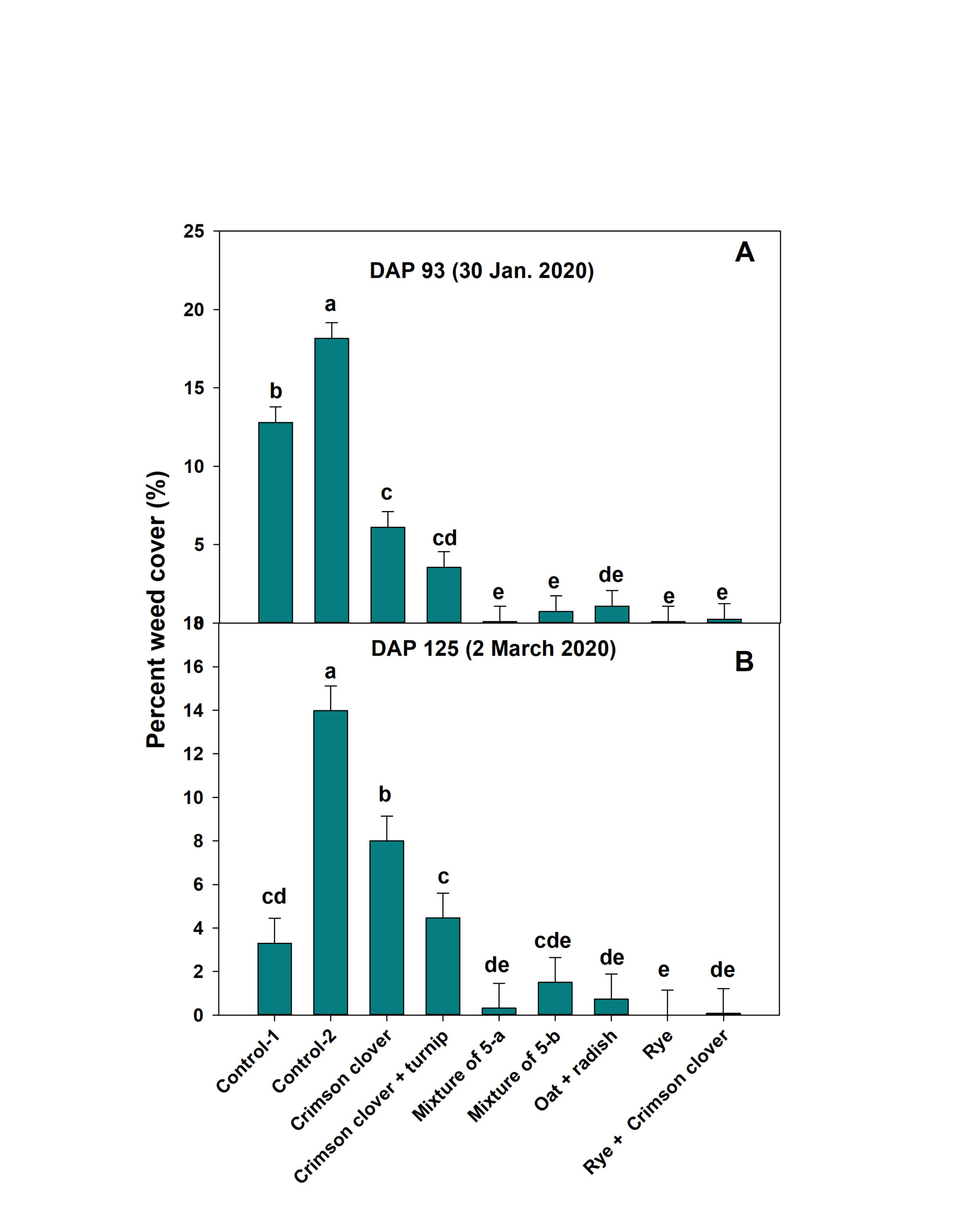
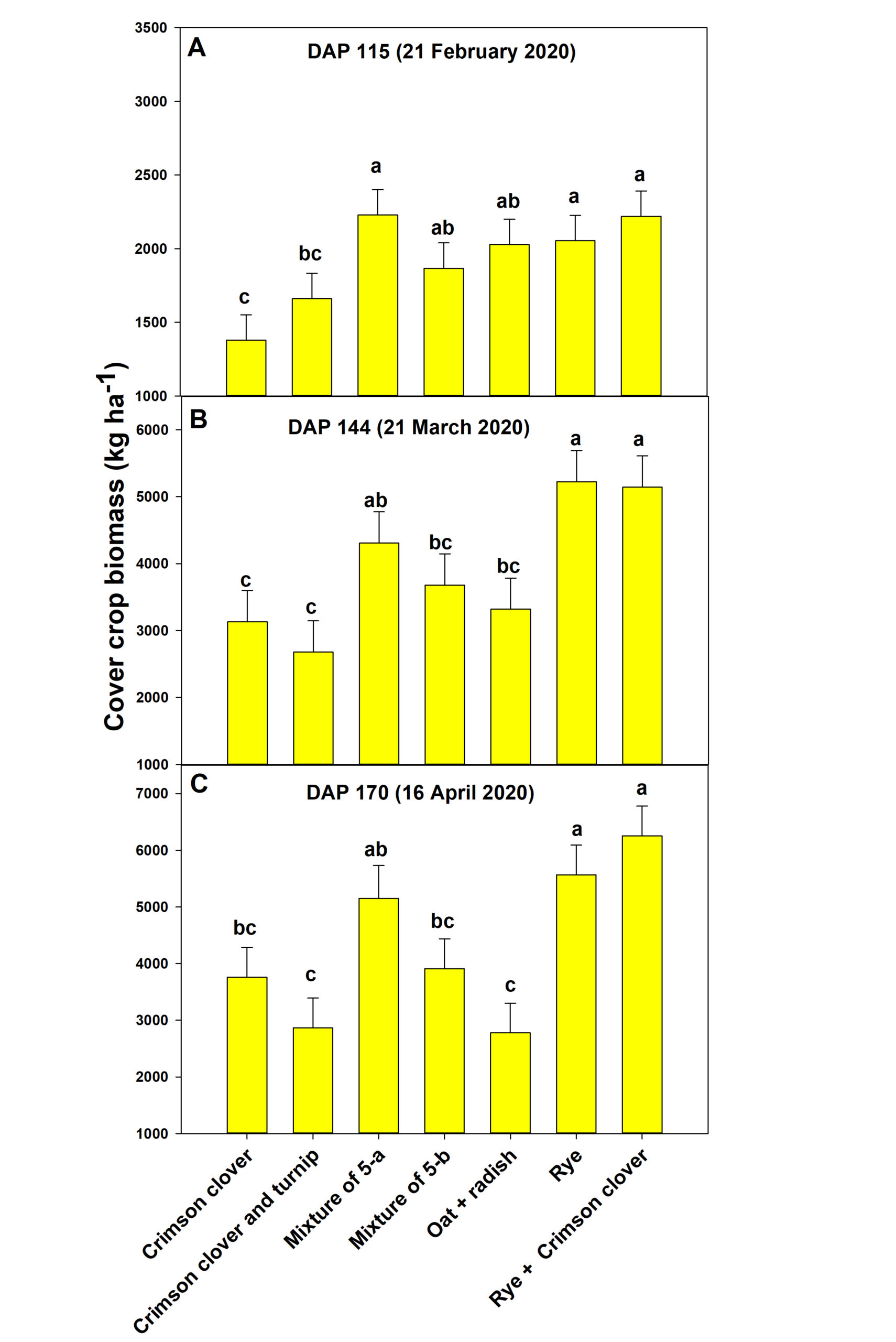
Cover cropping appeared to have an influence on soybean performance (Figure 4). Soybean plants were taller statured in the plots where the highest biomass producing cover crops: mixture of 5a, rye, and the mixture of rye and crimson clover, were grown in the previous season, compared to the no cover crop control (Figure 4A&B). Soybean biomass was also the highest in the plots where the highest biomass producing cover crops (mixture of 5a, rye, and the mixture of rye and crimson clover) were grown in the previous season (Figure 4C). Compared to the no cover crop control, mixture of 5a and the mixture of rye and crimson clover significantly increased soybean biomass. Though soybean yield generally showed some numerical increases in the plots where cover crops were grown in the previous season, the differences were not statistically significant (Figure 4D). This may be because significant amounts of cover crop residues were removed unintentionally from the plots before soybean planting. In the second field season, we will retain the residues in the field and assess whether yield differences become more prominent.
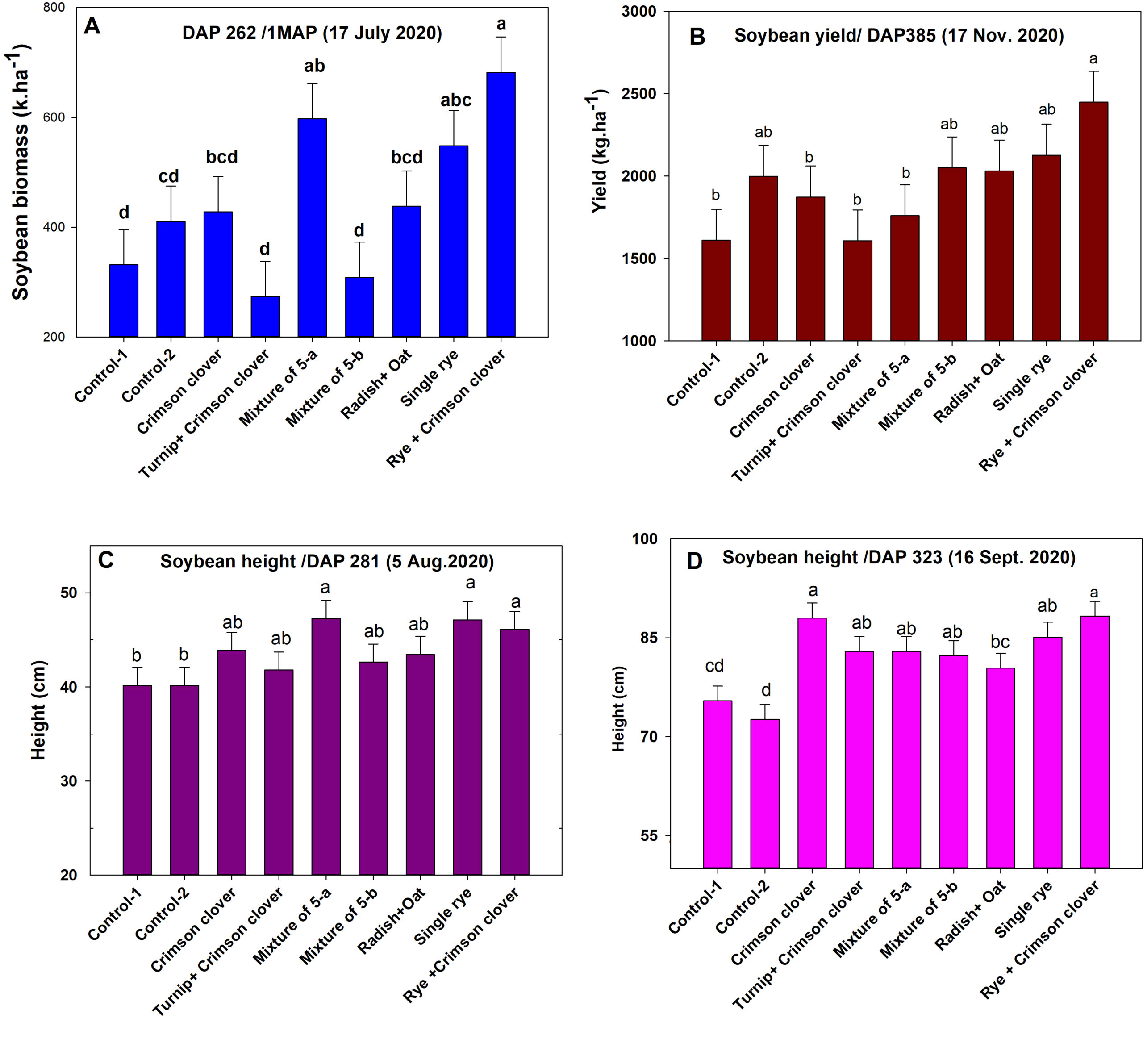
Though mixture of 5a, rye, and the mixture of rye and crimson clover were the best biomass producers and on par in terms of many other traits; when soil health was considered, mixture of 5a was superior to rye and the mixture of rye and crimson clover (Figure 5). The soil respiration and soil health score were higher in the plots where the mixture of 5a was grown compared to that in the control plots. On the other hand, these soil health parameters did not show any improvement under rye and the mixture of rye and crimson clover compared to the control treatments.
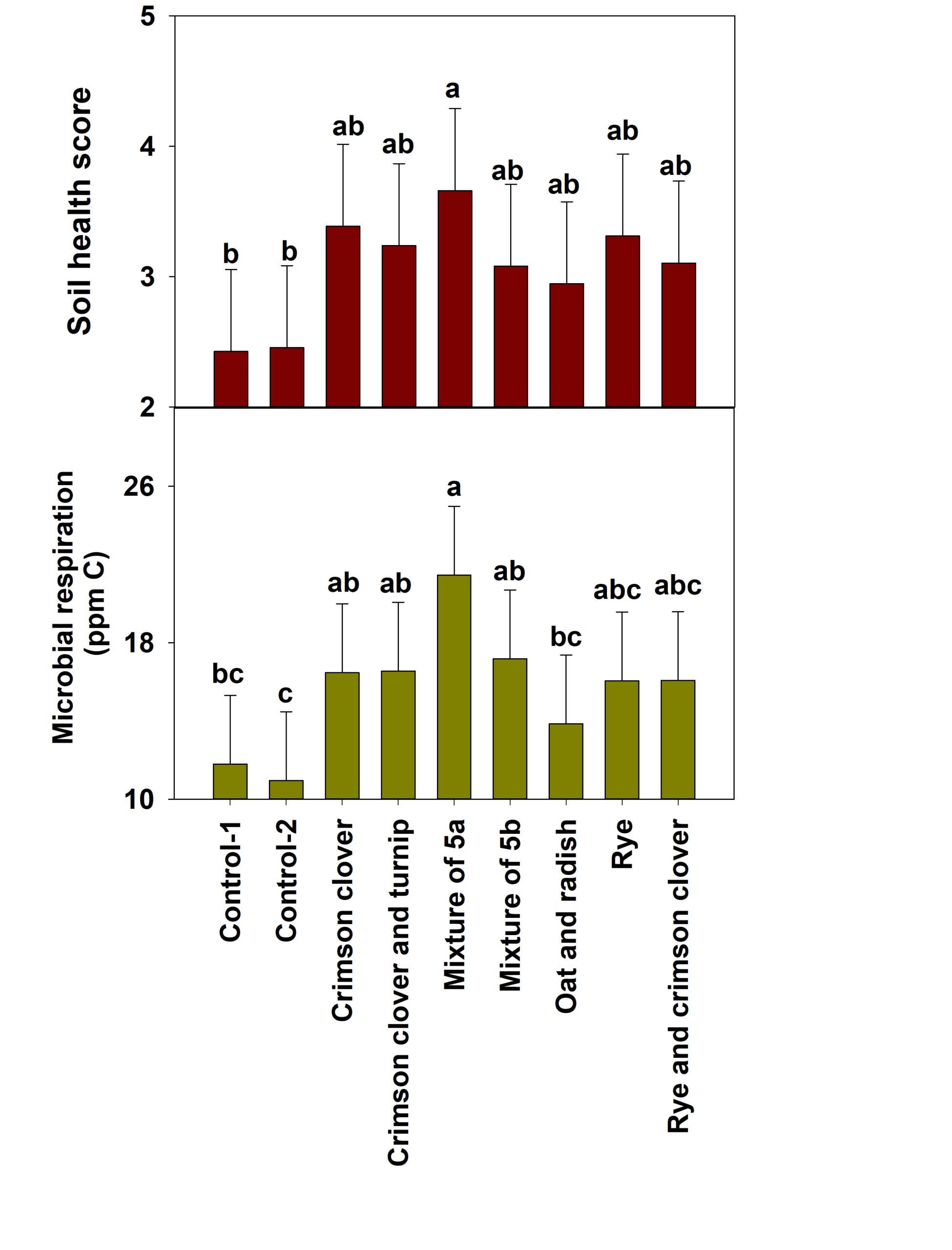
In conclusion, mixture of 5a, rye, and the mixture of rye and crimson clover were the best cover crops in terms of biomass production and improving soybean performance. However, mixture of 5a was superior when soil health improvements were also considered.
Educational & Outreach Activities
Participation Summary:
The graduate student who worked on this project presented research results at field days and agricultural meetings. Our extension agent cooperator, Chris Talley and farmer cooperator, Daniel Millam were enthusiastic to disseminate the research results to as many producers as possible through personal communication.
The PI, co-investigators, and the farmer cooperator worked with the student and trained him for cover crop culture and data collection, analysis, and interpretation. We anticipate that this training will help grow a new ‘sustainable agriculture’ professional.
Publications on cover cropping for weed control, soil health, and soil moisture conservation, based on the results of the proposed project, will be developed after the second field season (2020-2021) data become available and analyzed.
Learning Outcomes
Project Outcomes
The conventional row crop producers rely primarily on herbicides for weed control. On the other hand, organic row crop producers rely primarily on cultural and mechanical practices to manage weeds, and consider weed control among their greatest production costs. Growing numbers of row crop producers are adopting sustainable practices in response to increased demands from both organic livestock producers and final consumers. This is evident from expansion of certified organic cropland by nearly 80%, to 3.1 million acres between 2005 and 2011 in the US. Thus, development of more effective non-chemical weed management strategies can have substantial positive economic and environmental impacts, as far as conventional (inorganic) and organic row crop production are considered. The use of cover crops offers a more sustainable, system-based approach to weed management than herbicides and tillage.
Apart from weed infestation, other major challenges for organic and conventional farmers are lack of diversity in the production system that makes it less adaptable to extreme climatic events and deterioration of soil health that affects long term sustainability of the system (NORA, 2016; personal communication with farmers). In order to address the above challenges, crop production needs methods that make the system more diverse, protect the environment and are sustainable in the long run, which makes cover cropping a suitable approach to address those challenges. However, farmers may be reluctant to adopt the system without seeing it in action. This project has identified some suitable cover crops for the region that enhance soil health and suppress weed growth to benefit the following cash crop. The project provided farmers with an opportunity to see the system in action. The project addresses roadblocks to producer adoption of cover crops by (1) determining suitable cover crops for the region, (2) identifying benefits of cover crops compared with conventional fallow practices, and (3) dissemination of research results to producers, extension agents, and other researchers through a strong outreach program. We anticipate that our results will motivate row crop producers for greater adoption of cover cropping, reduced use of herbicides and fertilizers, and development of soil organic matter leading to healthier soils. In addition, the use of water-use-efficient cover crops that will improve soil health and nutrient availability and suppress weed growth for subsequent cash crop could reduce irrigation, herbicide, and fertilizer costs, and thus improve the economic feasibility and sustainability of cover cropping practices.